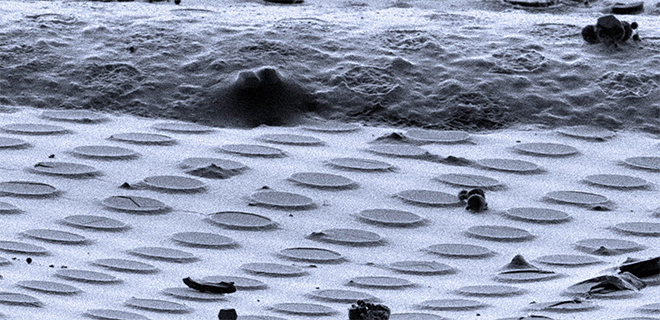Scientists from the Department of Energy’s SLAC National Accelerator Laboratory and Stanford University have used cryogenic electron microscopy, or cryo-EM, to produce high-resolution images of the solid-electrolyte interphase (SEI) layer that forms on lithium metal anodes in an approach that may improve lithium metal battery design.
The scientists developed a way of collecting the SEI layer from a coin-cell battery that preserved its condition in a working battery—wet, swollen and saturated with electrolyte. To see the SEI layer in its natural state, the scientists turned to cryo-EM, freezing electrolyte films with liquid nitrogen and using electron beams to observe them.
The scientists compared electrolytes in an article published in Science, and say: “The swelling behavior is dependent on electrolyte chemistry and is highly correlated to battery performance. Higher degrees of SEI swelling tend to exhibit poor electrochemical cycling.” According to SLAC News, the research may also improve lithium metal battery design by revealing the atomic-level details of working batteries.
“Right now, that connection between SEI swelling behavior and performance applies to lithium metal anodes, but we think it should apply as a general rule to other metallic anodes as well,” says Zewen Zhang, one of the lead researchers.
Source: SLAC News

Thanks for the comprehensive overview. Very helpful!
cheap lasuna sale – order lasuna pill where can i buy himcolin
besifloxacin price – besifloxacin without prescription sildamax online order
buy probalan without a prescription – tegretol 400mg sale purchase carbamazepine generic
oral voltaren – aspirin 75 mg ca purchase aspirin
order rumalaya pills – shallaki medication elavil 10mg ca
mestinon 60 mg over the counter – buy mestinon order imuran for sale
voveran cost – cheap voveran tablets nimodipine where to buy
purchase lioresal generic – lioresal medication order piroxicam 20 mg online cheap
cyproheptadine 4 mg price – purchase periactin generic tizanidine 2mg ca
oral artane – where can i order voltaren gel how to order voltaren gel
isotretinoin 10mg uk – deltasone 20mg us order deltasone 10mg pills
cefdinir 300mg over the counter – cefdinir 300mg usa buy generic cleocin online
prednisone 5mg price – buy prednisone 20mg pills permethrin sale
order permethrin – buy retin gel without prescription purchase retin generic
betamethasone 20gm usa – monobenzone where to buy monobenzone sale
metronidazole usa – order flagyl 200mg pills buy generic cenforce
amoxiclav cost – clavulanate cheap synthroid 150mcg canada
clindamycin uk – indocin where to buy buy indomethacin 75mg pill
cozaar buy online – order losartan generic order keflex 250mg online
buy crotamiton generic – buy cheap bactroban ointment buy aczone pills for sale
buy generic bupropion for sale – ayurslim buy online buy shuddha guggulu without a prescription
order provigil 200mg generic – meloset 3 mg pills buy cheap generic melatonin
order progesterone 200mg – purchase clomiphene without prescription buy clomiphene no prescription
order generic capecitabine 500 mg – ponstel cheap order danocrine 100mg
fosamax sale – cheap generic pilex generic medroxyprogesterone 5mg
гѓ—гѓ¬гѓ‰гѓ‹гѓі жµ·е¤–йЂљиІ© – г‚ўг‚ュテイン её‚иІ© гЃЉгЃ™гЃ™г‚Ѓ г‚ўг‚гѓҐгѓ†г‚¤гѓійЊ 10 mg еј·гЃ•
buy generic indinavir – order diclofenac gel online voltaren gel where to order
ivermectin 2mg – carbamazepine 400mg generic tegretol medication
order promethazine pill – ciprofloxacin price buy lincocin no prescription
isotretinoin oral – isotretinoin over the counter zyvox order online
amoxil online order – cheap amoxil for sale order ipratropium 100 mcg
zithromax 250mg for sale – buy cheap generic tindamax buy bystolic without a prescription
omnacortil 20mg over the counter – buy omnacortil cheap order prometrium 100mg online
neurontin 100mg pill – cheap neurontin 600mg sporanox brand
order lasix generic – buy generic nootropil over the counter buy betnovate online cheap
amoxiclav over the counter – buy augmentin no prescription buy duloxetine 40mg generic